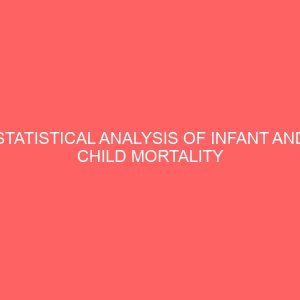Description
CHAPTER ONE
- INTRODUCTION
This research is on Effects of quail (coturnix japonica) egg diet on blood sugar and lipid profile levels of alloxan induced diabetic albino rats. Good nutrition affects growth and development of the human body. Nutritional composition research has shown that eating well-balanced food can improve human health. Variety of foods, including vegetables, fruits, grain, and protein, are essential for the full range of nutrients required for good health. The right balance of calories, protein, fat, carbohydrates, vitamins, and minerals provides energy and the variety of nutrients for growing children and for working adults. Foods that are high in fat, sugar, or salt should be limited in consumption because they do not provide important nutrients. Both the Child and Adult Care Program (CACFP) meal pattern, and the Pyramid Web site by US Department of Agriculture, Food and Nutrition Service, encourage eating variety of foods (US Department of Agriculture, Food and Nutrition Service, 2005).
Egg consumption is a popular choice for good nutrients, but by a wide margin the egg most often humanly consumed is the chicken egg, typically unfertilized (Applegate, 2000). The avian egg is an important source of nutrients, containing the proteins, lipids, vitamins, minerals, and growth factors required by the developing embryo, as well as a number of defence factors to protect against bacterial and viral infection. Moreover, eggs contain substances with biological functions and activities, i.e. immune proteins, enzymes, etc. (Hansen et al., 1998; Nowaczewski et al., 2013), characterized by anti-adhesive and antioxidant properties, antimicrobial activities, immunomodulatory, anticancer, and antihypertensive activities, protease inhibitors, nutrient bioavailability, and functional lipids, highlighting the importance of egg and egg components in human health and in disease prevention and treatment (Kovacs-Nolan et al., 2005). Emphasis has been on poultry birds, whereas nutritive and economic benefits can also be derived from quail production since the quail bird is fast growing and resistant to more diseases, especially the Newcastle disease, than the domestic fowl (Oluyemi and Roberts, 2000).
- JUSTIFICATION OF STUDY
With the world facing explosive increase in diabetes mellitus, there is a serious challenge to primary health care in developing countries with negative consequences on the economy. According to the International Diabetes Federation (IDF) 2014 updates, out of the world seven billion population, 387million people, aged 20–79 y ears worldwide are diabetic, (IDF, 2014) giving a comparative prevalence of 8.3%, while 46.3% cases are undiagnosed . In every 7 seconds, a person dies of diabetes, with 4.9 million deaths in 2014 alone. Seventy seven percent (77%) of people with diabetes live in low and middle income countries. Africa has a recorded incidence of 2,150,274 (5.05%) diabetic patients with over 13million undiagnosed cases. In Nigeria, there are estimated 374,651 diabetic cases, with over 172,339 undiagnosed cases. These figures account for about 4.64% Nigerian adults between ages 20-79 living with diabetes. An estimated 105,090 Nigerians died in 2014 as a result of diabetes. An average diabetic Nigerian spent about ₦43,527.16 (US $178.39) in 2014 due to diabetes treatment (IDF, 2014). With this alarming prevalence rate, diabetes mellitus poses a major challenge globally and accounts for a number of disabilities and deaths worldwide.
Currently, diabetes therapy is based on the use of hypoglycemic drugs (sulfonamides, biguanides, and insulin), on hygieno-diet measures, exercise, and requires a lifelong treatment (IDF, 2014). With the level of poverty in developing nations like Nigeria, the need for a better and cheaper medication cannot be over emphasized. This informed the need of this study, to use Quail eggs as a cheap and alternative therapeutic means for the treatment and management of diabetes.
In most recent times (between 2013–2015) in Nigeria , Quail eggs received ample claims and publicity of being a wonder drug / diet (i.e. being able to treat diabetes and other life threatening diseases such as anaemia, HIV/AIDS, infertility, high blood pressure, e.t.c.) (http://quailfarm.co.uk/index.php/quail-and-health). This study also centred on verifying Quail egg’s acclaimed efficacy in the treatment and management of diabetes; using alloxan induced diabetic rats as research models.
Diabetes tends to lower “good” cholesterol levels and raises triacylglycerol and “bad” cholesterol levels, which increases the risk of heart disease and stroke. This common condition is called diabetic dyslipidemia (lipid profile going in the wrong direction). Dyslipidemia is characterized by elevated low-density lipoprotein–cholesterol (LDL-C ), triacylglycerol (TG), and total cholesterol (TC) levels, and lowered high-density lipoprotein–c holesterol (HDL-C) levels (Betteridge, 2000 and Barrett-Connor et al., 1982). This is a deadly combination that puts patients at the risk of premature coronary heart disease and atherosclerosis — a condition where the arteries become clogged with accumulated fat and other substances. Studies show a link between insulin resistance, which is a precursor to type 2 diabetes, and diabetic dyslipidemia, atherosclerosis and blood vessel diseases. These conditions can develop even before diabetes is diagnosed (http://www.heart.org/HEARTORG/Conditions/Diabetes/WhyDiabetesMatters/Cholesterol-
Abnormalities-Diabetes_UCM_313868_Article.jsp#.Vo6zH17a1dg. accessed 21st Aug., 2015). Insulin resistance and type 2 diabetes are associated with a clustering of interrelated plasma lipid and lipoprotein abnormalities, which include reduced HDL cholesterol, a predominance of small dense LDL particles, and elevated triacylglycerol levels (American Diabetes Association, 2003). Each of these dyslipidemic features is associated with an increased risk of cardiovascular disease. Increased hepatic secretion of large triacylglycerol -rich VLDL and impaired clearance of VLDL appears to be of central importance in the patho-physiology of dyslipidemia. Small dense LDL particles arise from the intravascular processing of specific larger VLDL precursors. Although behavioural interventions such as diet and exercise can improve diabetic dyslipidemia, for most patients, pharmacological therapy is needed to reach treatment goals. There are several classes of medications that can be used to treat lipid and lipoprotein abnormalities associated with insulin resistance and type 2 diabetes, including statins, fibrates, niacin, and thiazolidinediones (American Diabetes Association, 2003). Clinical trials have shown significant improvement in coronary artery disease after diabetic dyslipidemia treatment (Betteridge, 2000 and Barrett-Connor et al., 1982).
Insulin resistance may play a pivotal role in the development of diabetic dyslipidemia by influencing several factors. In insulin resistance and type 2 diabetes, increased efflux of free fatty acids from adipose tissue and impaired insulin-mediated skeletal muscle uptake of free fatty acids increase fatty acid flux to the liver (Boden, 1997; Kelley and Simoneau, 1994). The fact that free fatty acid levels are elevated in individuals with impaired glucose tolerance suggests that insulin resistance associated with elevated free fatty acid levels occurs before the onset of hyperglycemia (Bluher et al., 2001). One study conducted in patients without diabetes showed that decreased glucose utilization in muscle was associated with acute elevation of free fatty acids (Dresner et al., 1999). Epidemiologic studies have also demonstrated a relationship between plasma free fatty acid levels and insulin resistance (Reaven and Chen, 1988). In the presence of insulin resistance, free fatty acids from triacylglycerol lipolysis are deposited in muscle, liver, heart, and pancreas. Notably, agents that lower elevated free fatty acids, such as the thiazolidinediones (TZDs), have been shown to improve insulin sensitivity in muscle, liver, and adipose tissues (Mayerson et al., 2002 and Miyazaki et al., 2002).
Insulin resistance also increases hepatic lipase activity which is responsible for hydrolysis of phospholipids in LDL and HDL particles, resulting in the formation of smaller and denser LDL particles and a decrease in HDL2 (Tan et al., 1995; Watson et al., 1994 and Zambon et al., 1993).
This study is an attempt to justify the use of Quail egg diet, a form of behavioural intervention, as an effective alternative in the treatment and management of diabetic dyslipidemia in a situation where the alloxan induced diabetic rats become dyslipidemic.
- AIMS AND OBJECTIVES OF THE STUDY
This study was designed with the following aims and objectives:
- To determine the nutritional and elemental composition of the quail (Coturnix japonica) egg that is, the composition of both the whole quail egg and its shell.
- To determine the effects of quail (Coturnix japonica) egg diet on both the blood glucose level and the lipid profile levels of alloxan induced diabetic albino rats.
- To ascertain the histological effect of a synergetic mixture of processed quail egg and its shell on the liver and kidney cells of experimental rats.







